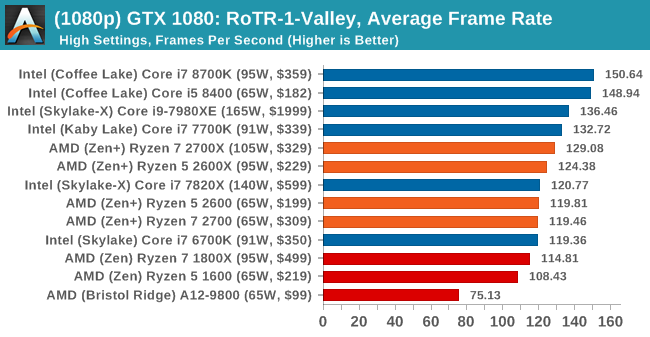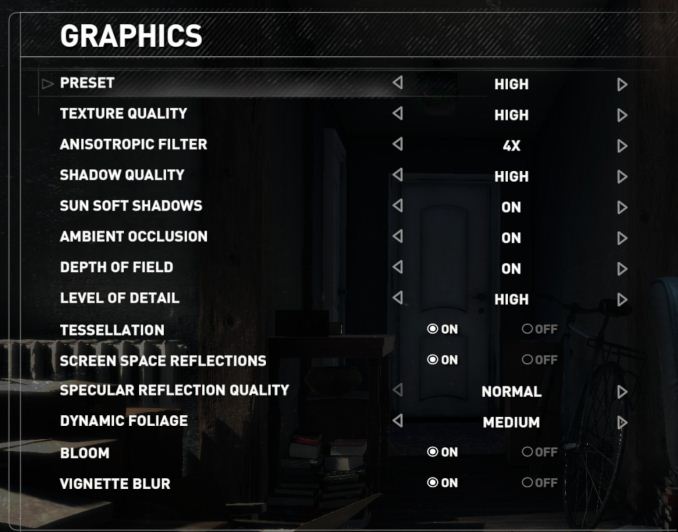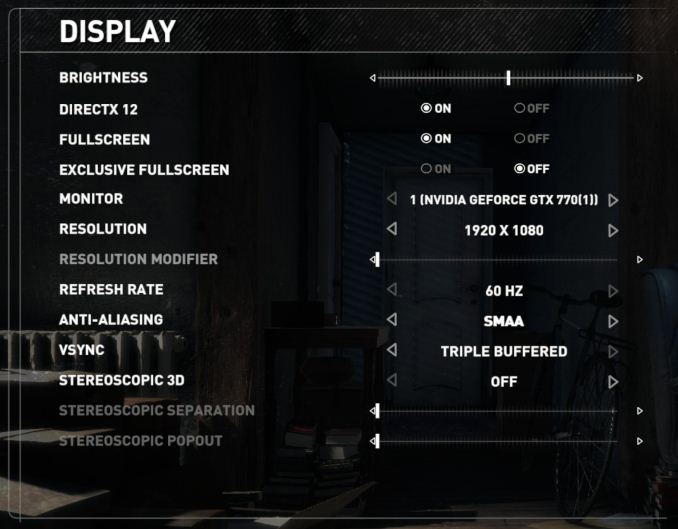The AMD 2nd Gen Ryzen Deep Dive: The 2700X, 2700, 2600X, and 2600 Tested
by Ian Cutress on April 19, 2018 9:00 AM ESTRise of the Tomb Raider
One of the newest games in the gaming benchmark suite is Rise of the Tomb Raider (RoTR), developed by Crystal Dynamics, and the sequel to the popular Tomb Raider which was loved for its automated benchmark mode. But don’t let that fool you: the benchmark mode in RoTR is very much different this time around.
Visually, the previous Tomb Raider pushed realism to the limits with features such as TressFX, and the new RoTR goes one stage further when it comes to graphics fidelity. This leads to an interesting set of requirements in hardware: some sections of the game are typically GPU limited, whereas others with a lot of long-range physics can be CPU limited, depending on how the driver can translate the DirectX 12 workload.
Where the old game had one benchmark scene, the new game has three different scenes with different requirements: Geothermal Valley (1-Valley), Prophet’s Tomb (2-Prophet) and Spine of the Mountain (3-Mountain) - and we test all three. These are three scenes designed to be taken from the game, but it has been noted that scenes like 2-Prophet shown in the benchmark can be the most CPU limited elements of that entire level, and the scene shown is only a small portion of that level. Because of this, we report the results for each scene on each graphics card separately.
Graphics options for RoTR are similar to other games in this type, offering some presets or allowing the user to configure texture quality, anisotropic filter levels, shadow quality, soft shadows, occlusion, depth of field, tessellation, reflections, foliage, bloom, and features like PureHair which updates on TressFX in the previous game.
Again, we test at 1920x1080 and 4K using our native 4K displays. At 1080p we run the High preset, while at 4K we use the Medium preset which still takes a sizable hit in frame rate.
It is worth noting that RoTR is a little different to our other benchmarks in that it keeps its graphics settings in the registry rather than a standard ini file, and unlike the previous TR game the benchmark cannot be called from the command-line. Nonetheless we scripted around these issues to automate the benchmark four times and parse the results. From the frame time data, we report the averages, 99th percentiles, and our time under analysis.
All of our benchmark results can also be found in our benchmark engine, Bench.
1080p



4K

















545 Comments
View All Comments
SaturnusDK - Thursday, April 19, 2018 - link
Surely you mean widening the performance gap. It was already ahead in professional and multi-threaded workloads. Now it's miles ahead.MajGenRelativity - Thursday, April 19, 2018 - link
I was referring to single-threaded performance. As for multi-threaded workloads, you are rightfallaha56 - Thursday, April 19, 2018 - link
Like which ones?After the Spectre2 patch the Intel scores have been hammered...
And no doubt with proper default settings on MCE as well
jjj - Thursday, April 19, 2018 - link
Very odd choice to only include the Intels with high clocks in the charts, it's like you wanted to put all Intels at top in ST results, make it look better than it is.Luckz - Monday, April 23, 2018 - link
I'm afraid there are physical space limits regarding how much hardware Ian can fit in his domain. It's been popular to recycle scores from previous tests among sites, but after "Smeltdown" (and with Nvidia drivers being all over the place) it doesn't work that way right now. In an ideal world you'd compare five or ten different setups, sure.But then you'd not just want 8400 @ B360 but also 8700k OC, 2600k OC, 4770k OC, etc...
T1beriu - Thursday, April 19, 2018 - link
Typo: "Cycling back to that Cinebench R15 nT result that showed a 122% gain". I think the gain is just 22%.SirCanealot - Thursday, April 19, 2018 - link
Wow. I'm actually excited to read a review for the first time in a long time! Fantastic review as usual!I'm still sitting on my 3770k @ 4-4-4.7ghz and I'm likely to try delidding for fun and see if I can push it any more. But this review makes me excited to look forward to perhaps building a Ryzen 2/3 (whatever the heck they name it) this time next year!
AMD has caught up to Intel another vital few paces here! If Intel sits on their butts again next year and AMD can do the same thing next year, this is going to get very, very interesting :)
SmCaudata - Thursday, April 19, 2018 - link
I'm sitting on a 2500k. The geek in me wants to upgrade, but I've really no need until Cyberpunk finally releases. Maybe zen 5 by that time.Lolimaster - Thursday, April 19, 2018 - link
You can upgrade to the new 400 mobos, it will be compatible with any Ryzen released till 2020.Luckz - Monday, April 23, 2018 - link
Four times the threads though, four times.Depends on what you do, of course :)